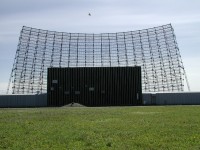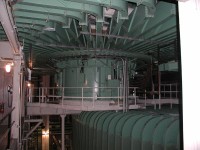Clear AFS, AK
Scanner Buildings

From the transmitters, the energy traveled down the long tunnels to the scanner buildings, 104, 105, and 106. The tunnels are lined with huge wave guides (the large, square conduits going down the axis of the tunnel), which have accordion-like expansion joints to deal with the extreme Alaskan temperatures (sometimes more than a 140 degree swing from summer to winter).

The scanner building itself is one of the amazing sights at Clear. Each of the three scanner buildings had two scanners. The best way to describe the scanner's function is to think of it like a distributor cap in a car. The energy from the transmitter comes into the scanner, which spins inside a large cylinder. Inside that cylinder are the "contacts" for the wave guides, which will take the energy to the scanner building face (the "sparkplug" if you will) to be projected onto the radar fence. The scanner hits each wave guide sequentially to send a smooth stream of energy in a sweeping motion across the radar fence, just like the distributor cap makes all the cylinders fire in the correct order.
The detection radars project energy in two "fans": the upper fan and lower fan, hence the need for two scanners per DR. Incidentally the upper-fan scanner is the one on the bottom of the scanner building and the lower-fan scanner is on the top (it's all a matter of making it reflect correctly off the fence). The entire scanner building looks like one big pipe organ and is truly an "engineering art."
The energy emitted from these scanners was reflected thousands of miles into space and then reflected back from orbiting objects including possible threat missiles.



|
NEWSLETTER
|
| Join the GlobalSecurity.org mailing list |
|
|
|

